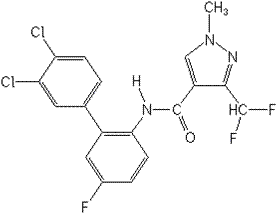|
bixafen
IUPAC: N-(3',4'-dichloro-5-fluorobiphenyl-2-yl)-3-(difluoromethyl)-1-methylpyrazole-4-carboxamide
CAS: N-(3',4'-dichloro-5-fluoro[1,1'-biphenyl]-2-yl)-3-(difluoromethyl)-1-methyl-1H-pyrazole-4-carboxamide
Reg. No.: 581809-46-3
Formula: C18H12Cl2F3N3O
Molecular mass (g mol-1): 414.21
Activity: fungicides
Structure:

Formulation and application details: Usually supplied as an emulsifiable concentrate.
Physical and chemical properties:
Physical state: White powder
Solubility - In water at 20oC (mg/L): 0.49
Solubility - In organic solvents at 20oC (mg/L): 250000 (Acetone); 102000 (Dichloromethane); 32000 (Methanol); 16000 (Toluene)
Melting Point (oC): 146.6
Boiling Point (oC): Decomposes before boiling
Degradation point (oC): 250
Flashpoint (oC): Not highly flammable
Octanol-water partition coefficient at pH 7, 20oC :
P : 2.00 X 1003 Calculated
Log P : 3.3 @ 40 DegC
Usage:
Bixafen is classified under succinate dehydrogenase inhibitors and pyrazole-carboxamides. This fungicide was specifically developed for the control of fungi under Ascomycotina, Basidiomycotina and Deuteromycotina infecting cereals, such as Septoria tritici [Mycosphaerella graminicola], Puccinia triticina [Puccinia recondita], Puccinia striiformis, Oculimacula spp. and Pyrenophora tritici-repentis in wheat, and Pyrenophora teres, Ramularia collo-cygni, Rhynchosporium secalis, Puccinia hordei and physiological leaf spot in barley. Bixafen also has highly favourable toxicological and ecotoxicological profiles.
Application rate:
Bayer's product Aviator Xpro(bixafen75g/L+prothioconazole150g/L)is used in control of winter wheat, rye and triticale, application rate is 1.25L / ha, barley 1L / ha. The product is used to control other diseases in the wheat leaf blister disease (Septoria) and leaf rust.
Toxicity:
Mammals - Acute oral LD50 (mg/kg): > 5000 (Rat)
Mammals - Dermal LD50 (mg/kg body weight):> 5000 (Rat)
Mammals - Inhalation LC50 (mg/L): > 5.38 (Rat)
Other Mammal toxicity endpoints :
ADI - Acceptable Daily Intake (mg/kgbw/day): 0.02 (Rat, SF=100)
ARfD - Acute Reference Dose (mg/kgbw/day): 0.2 (Rat, SF=100)
AOEL - Acceptable Operator Exposure Level - Systemic (mg/kgbw/day): 0.13 (Rat, SF=100)
Dermal penetration studies (%): 0.7-4.1 (concentration dependant)
ECOTOXICOLOGY:
Mammals - Acute oral LD50 (mg/kg): > 5000 (Rat),Low toxicity
Birds - Acute LD50 (mg/kg): > 2000 (Colinus virginianus), Moderate toxicity.
Birds - Short term dietary (LC50/LD50): > 1159 mg/Kg BW/day
Fish - Acute 96 hour LC50 (mg/L): 0.095 (Oncorhynchus mykiss),High toxicity.
Fish - Chronic 21 day NOEC (mg/L): 0.0046 (Pimephales promelas) 33days
Aquatic invertebrates - Acute 48 hour EC50 (mg/L): 1.2 (Daphnia magna), Moderate toxicity.
Aquatic invertebrates - Chronic 21 day NOEC (mg/L): 0.05 (Daphnia magna)
Sediment dwelling organisms - Chronic 28 day NOEC, static, water (mg/L): 0.0156 (Chironomus riparius), Moderate toxicity
Sediment dwelling organisms - Chronic 28 day NOEC, sediment (mg/kg): 20.0 (Chironomus riparius),Moderate toxicity
Algae - Acute 72 hour EC50, growth (mg/L): 0.097 (Pseudokirchneriella subcapitata),Moderate toxicity
Honeybees - Acute 48 hour LD50 ((μg/bee) : > 100 (Oral),Moderate toxicity
Earthworms - Acute 14 day LC50 (mg/kg):> 1000, Moderate toxicity
Earthworms - Chronic 14 day NOEC, reproduction (mg/kg): 41.5, Moderate toxicity
|